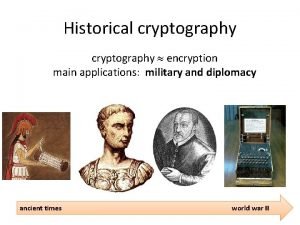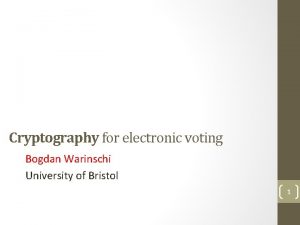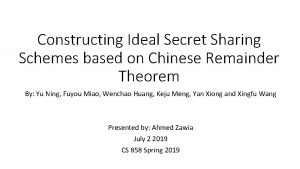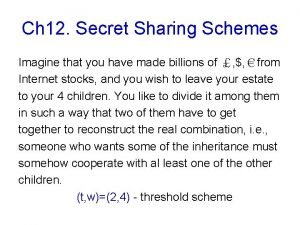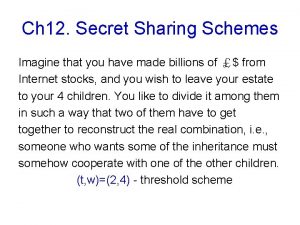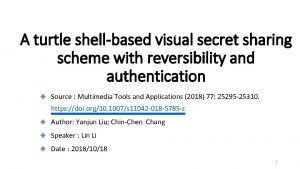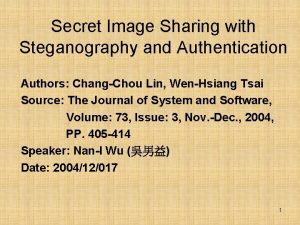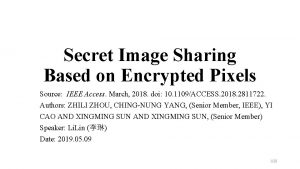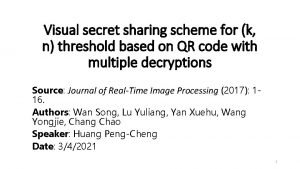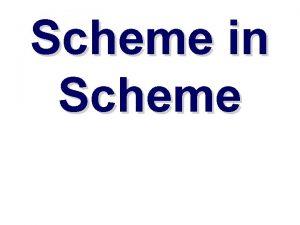Secret Sharing and Applications Secret Sharing Threshold Scheme











- Slides: 11

Secret Sharing and Applications

Secret Sharing- Threshold Scheme Ø The safety of all keys stored in the system- and the entire system-may depend on a single master key. This has two serious drawbacks. First, if the master key is accidentally or maliciously exposed, the entire system is vulnerable. Second, if the master key is lost or destroyed, all information in the system becomes inaccessible. The latter problem can be solved by giving copies of the key to “trustworthy” users. But in so doing, the system becomes vulnerable to betrayal.

Secret Sharing- Threshold Scheme Ø The solution is to break a key k into n shadows ( pieces) k 1, ……. . kn in such a way that: 1. With knowledge of any t of the ki, computing k is easy; and 2. With knowledge of any t-1 or fewer of the ki, determining k is impossible because of lack information. Ø The n shadows are given to n users. Because t shadows are required to reconstruct the key, exposure of a shadow does not endanger the key, and no group of less than t of the users can conspire to get the key. At the same time, if a shadow is lost or destroyed, key recovery is still possible. Such schemes are called (t , n ) threshold schemes.

Two Extreme Cases Ø (1, n) threshold scheme can be constructed by duplicating the same key k to all users. Ø (n , n) threshold scheme can be constructed by randomly selecting k 1, k 2, ………. , kn-1, and determining kn=k k 1 k 2 ………. kn-1.

Secret Sharing based on the Lagrange Interpolating Polynomial Ø Shamir has proposed a scheme based on the Lagrange interpolating polynomial. The shadows are derived from a random polynomial of degree t-1: with constant term a 0=k. All arithmetic is done in the Galois field GF(p), where p is a prime number larger than both k and n. Given h(x), the key k is easily compute by k=h(0). The n shadows are computed by evaluating h(x) at n distinct values x 1, ………. . , xn : ki=h(xi) i= 1, 2, ………. , n.

Secret Sharing based on the Lagrange Interpolating Polynomial Ø Given t shadows ki , ………, ki , h(x)is reconstructed from the Lagrange Interpolating polynomial: 1 t

Secret Sharing based on the Lagrange Interpolating Polynomial Example: Let t=3, n=5, p=17, k=13, and h(x)=(2 x²+10 x+13) mod 17 with random coefficients 2 and 10. Evaluating h(x) at x=1, 2…, 5 , we get five shadows: k 1=h(1)=(2+10+13)mod 17=8 k 2=h(2)=(8+20+13)mod 17=7 k 3=h(3)=(18+30+13)mod 17=10 k 4=h(4)=(32+40+13)mod 17=0 k 5=h(5)=(50+50+13)mod 17=11 we can reconstruct h(x) from any three of the shadows. Using k 1, k 3, and k 5 we have:

Secret Sharing based on the Lagrange Interpolating Polynomial (continue)

Secret Sharing Without the Assistance of a Mutually Trusted Party Ø In case no trusted dealer is available, how to establish a secret sharing scheme? Example: Four users A, B, C and D need to set up a (2, 4) secret sharing without the assistance of a mutually trusted party. Each user selects a private key, ki, for i= A, B, C, D. Then secretly enters the private key one by one, and the system key is determined by k=k. A k. B k. C k. D.

Secret Sharing Without the Assistance of a Mutually Trusted Party Ø Then each user becomes the dealer and computes shares for other users using (2, 3) threshold scheme. Thus, they have users keys A B C D k k. A, B k. A, C k. A, D shares k. B, A k. B, C k. B, D based on k. C, A k. C, B k. C, D (2, 3) k. D, A k. D, B k. D, C threshold A scheme

Secret Sharing Without the Assistance of a Mutually Trusted Party Later, for example, when A, B work together, they know k. A, k. B. In addition, from k. C, A and k. C, B, they can reconstruct k. C. Similarly, from k. D, A and k. D, B , they can reconstruct k. D. Ø “Secret” can be either encryption key, like DES key, or private key, like DSS private key. Ø If it is a DES key, then each share can only be used once. Efficiency is very low. Ø If it is a DSS signing key, then due to the mathematical structure of public-key algorithm, each share does not need to be revealed directly.
